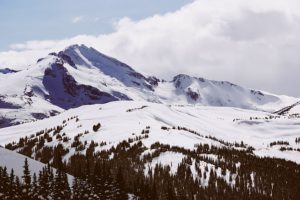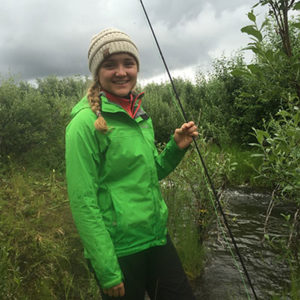Climate change and ski resorts:
The livelihood of winter recreation
By Emily Powell
As an avid skier, I treasure the beautiful, bright powder days that result from the heavy snowfall of winter storms. Years ago, these winter storms were consistent and reliable, bringing the glorious gift of fresh snow and stellar skiing/riding every winter. However, as the effects of climate change continue to escalate and make themselves more apparent, winter weather is becoming less predictable and more erratic. This is proving to be severely problematic for ski resorts, ski towns and even regional or state economies, whose revenue and livelihoods depend nearly exclusively on the tourists brought to town by heavy snowfall. As a result, ski resorts are forced to develop a business plan and political strategy more adaptable to volatile weather in order to survive in a world heavily impacted by climate change. In California, home to the famous Sierra Nevada, dozens of ski resorts and thousands of residents employed by the winter season’s activities, the “exceptional drought” of the past several years has left the annual snowpack excruciatingly low. In the 2014-2015 season, for example, the winter months brought only 5% of the normal snowfall. Lifts were closed, runs were dry, and ski resorts were forced to invest in advanced snowmaking technologies to stay open. For reference, Squaw Valley, a mountain resort giant nestled near Lake Tahoe, suffered a season profit downfall of nearly 25%.
In California, home to the famous Sierra Nevada, dozens of ski resorts and thousands of residents employed by the winter season’s activities, the “exceptional drought” of the past several years has left the annual snowpack excruciatingly low. In the 2014-2015 season, for example, the winter months brought only 5% of the normal snowfall. Lifts were closed, runs were dry, and ski resorts were forced to invest in advanced snowmaking technologies to stay open. For reference, Squaw Valley, a mountain resort giant nestled near Lake Tahoe, suffered a season profit downfall of nearly 25%.
This past season, heavier storms and more consistent weather brought a breath of relief to Northern California’s winter recreation industry, and raised hopes for more profitable weather this winter. Because of the warming climate, however, storms are more erratic, and temperatures can swing wildly out of normal ranges, leaving skeptical predictions for good snow this season. As extreme snowboarder Jeremy Jones, proponent of the lobbying organization Protect Our Winters, states, “It’s feast or famine these days, record breaking storm, record breaking lows, snowing in June, 70 degrees in February.” Because ski resorts are subject to these patterns, adapting to climate change, strategically investing in snowmaking technologies, offsetting carbon emissions, and galvanizing climate policy is becoming more of a priority.
Political organizations such as Protect Our Winters and Mountain Pact are advocating that the political and economic interests of mountain towns finally be acknowledged. Most of the climate conversation is centered around urban and coastal areas, despite the huge economic benefits of winter recreation to many states, including California, Colorado, Pennsylvania, and Vermont. In an effort to realize and accommodate the winter industry’s economic influence, Mountain Pact’s priorities are 1. Adaptation, 2. Mitigation, and 3. Federal prioritization. In their fight to make mountain towns more resilient, members work to expose federal policies that affect ski resorts and their communities, advocate the development of legislation that offsets and limits carbon emissions, improve community infrastructure and market diversity, and make the customer base more aware of the growing issue.
With a difficult and unpredictable future that is heavily dependent on the whims of Mother Nature, the winter ski industry is doing its best to adapt. Though the future may appear grim, many believe that the innovation and evolution of our world’s ski resorts will keep them afloat and thriving. As Squaw Valley’s CEO Andy Wirth states, as uncertain as living with climate change may be, there are firm reasons to believe that the ski industry will still make a profit. After all, aspiring ski bums like myself will always come back for more.
More cool resources:
The Six Most Environmentally Responsible Ski Resorts
NPR Special: Ski resort see slight thaw after chilling effect of climate change
Report by the NRDC and Protect Our Winters: How Climate Impacts Winter Tourism Emily’s exuberant passion for sustainability and sustainable nutrition stems from her everlasting love for the outdoors, people, dirt, and broccoli. As an undergraduate in the School of Sustainability at Arizona State University, Emily is working towards becoming a spokesperson for everyday sustainable food and lifestyle choices, including decisions on what foods you buy, where you buy them, and how you make the most of foods’ energy. Leveraging communication through writing, Emily has been recognized in competitions such as the DuPont Challenge and the Apprentice Ecologist Initiative for her essays on sustainability issues and initiatives, including Honeybee Colony Collapse Disorder and community gardens in elementary schools. Emily aspires to utilize relationships with other academic disciplines to plant the seeds of sustainability and nutrition principles in the young adults of her generation. She plans to earn her Registered Dietitian credential and work either on the community or personalized sustainable nutrition level.
Emily’s exuberant passion for sustainability and sustainable nutrition stems from her everlasting love for the outdoors, people, dirt, and broccoli. As an undergraduate in the School of Sustainability at Arizona State University, Emily is working towards becoming a spokesperson for everyday sustainable food and lifestyle choices, including decisions on what foods you buy, where you buy them, and how you make the most of foods’ energy. Leveraging communication through writing, Emily has been recognized in competitions such as the DuPont Challenge and the Apprentice Ecologist Initiative for her essays on sustainability issues and initiatives, including Honeybee Colony Collapse Disorder and community gardens in elementary schools. Emily aspires to utilize relationships with other academic disciplines to plant the seeds of sustainability and nutrition principles in the young adults of her generation. She plans to earn her Registered Dietitian credential and work either on the community or personalized sustainable nutrition level.
*Disclosure:
Some of the links in our podcast show notes and blog posts are affiliate links and if you go through them to make a purchase, we will earn a nominal commission at no cost to you. We offer links to items recommended by our podcast guests and guest writers as a service to our audience and these items are not selected because of the commission we receive from your purchases. We know the decision is yours, and whether you decide to buy something is completely up to you.







